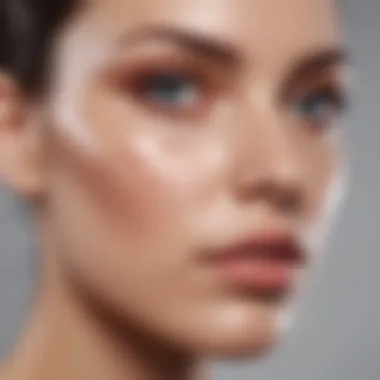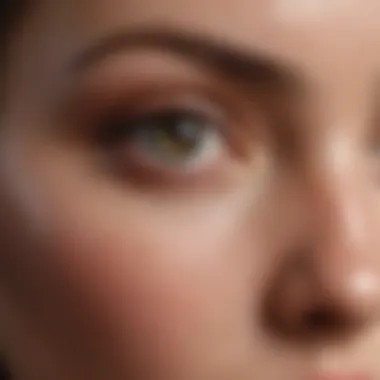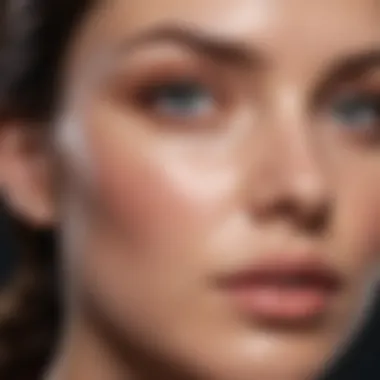Unlocking the Secrets of Under Eye Ingredients


Intro
Under-eye concerns are universal for many. From dark circles to puffiness, these signs of fatigue can affect how we perceive ourselves and how others perceive us. The skin here is thinner and more delicate, making it particularly susceptible to various environmental factors. In recent years, the skincare industry has seen significant advancements in addressing these issues. By harnessing the power of specific ingredients, we can cultivate a more fresh and vibrant appearance.
This article will delve into the most effective ingredients for under-eye care, focusing on how they work and their unique properties. By understanding each ingredient's benefits, you can enhance your skincare routine. It’s not just about the products; it's about making informed choices that have real benefits.
We will examine trending topics in the skincare world, guide you through specific routines, and review some popular items aimed at taking care of this vulnerable area. Armed with this knowledge, you can navigate the market more effectively and find solutions that truly meet your needs.
Prelude to Under Eye Care
The area under the eyes is particularly delicate and sensitive. Many factors contribute to under-eye concerns, including genetics, lifestyle choices, and environmental stressors. Therefore, it is essential to address this area with targeted treatments that focus on specific issues. The choice of products one applies can greatly influence the overall appearance and health of the skin in this region. Through the right ingredients, one can mitigate conditions like puffiness, dark circles, and the appearance of fine lines.
An effective under-eye care regimen not only improves cosmetic concerns but also boosts confidence. Using ingredients specifically formulated for this purpose allows for optimal results. As skin beneath the eyes is thinner compared to other areas, it can be more prone to dryness and irritation. Therefore, selecting the right components is not just about aesthetics but also about maintaining skin integrity.
The benefits of focused treatments extend beyond immediate visual effects. Ingredients such as Vitamin C, caffeine, and Hyaluronic Acid are known to enhance skin texture, brighten the area, and temporarily reduce puffiness. By understanding these ingredients and their effects, individuals can make more informed choices to achieve the desired outcome.
The Importance of Targeted Treatments
Targeted treatments are crucial in addressing specific under-eye concerns effectively. Unlike generic moisturizers, treatments designed for the under-eye area contain potent active ingredients that confront issues on multiple levels.
- Dark Circles: Certain ingredients can help lighten pigmentation, improving the overall brightness of the under-eye area.
- Puffiness: Some formulations feature natural extracts that promote circulation, reducing the appearance of swollen tissues.
- Fine Lines: Specialized ingredients provide hydration and stimulate collagen production, leading to firmer skin over time.
Using products specifically formulated for this area helps in achieving faster results. When individuals choose treatments that align with their skin concerns, they experience more effective outcomes. Furthermore, investing time in understanding the importance of these treatments equips them to craft a personalized skincare regimen. Overall, targeted treatments represent a crucial facet of under-eye care.
Common Under Eye Concerns
Under-eye concerns are prevalent among individuals of various ages and backgrounds. These issues can significantly affect one's appearance, leading to feelings of self-consciousness and highlighting the importance of addressing them. In this section, we will explore three primary under-eye concerns: dark circles, puffiness, and fine lines and wrinkles. Understanding each of these conditions is crucial for selecting the right ingredients for effective treatment and achieving desired aesthetic outcomes.
Dark Circles
Dark circles under the eyes often occur due to poor circulation, lack of sleep, or the natural aging process. They can create a tired appearance, which may not reflect one’s actual health status. The skin near the eyes is particularly thin and delicate, making veins and underlying darkness more visible.
Common contributing factors include:
- Genetics: Some people are predisposed to dark circles due to hereditary traits.
- Lifestyle Factors: Insufficient sleep, dehydration, and excessive alcohol or caffeine consumption can exacerbate this issue.
- Environmental Stressors: Pollution and sun exposure may also result in pigmentation changes over time.
To combat dark circles, ingredients like Vitamin C and Niacinamide are beneficial, as they can promote brightness and improve overall skin texture.
Puffiness
Puffiness around the eyes is often linked to fluid retention, inflammation, or irritation. Factors such as allergies, hormonal changes, dietary habits, or even sleeping posture can contribute to this condition.
Key contributors include:
- Allergic Reactions: Pollen, dust, or certain skincare products can lead to localized swelling.
- Diet: High salt intake may cause the body to retain excess fluid, increasing the likelihood of puffiness.
- Fatigue: Lack of adequate rest can lead to accumulated stress that manifests physically.
Ingredients such as caffeine and Green Tea Extract have become popular for their anti-inflammatory properties, offering a cooling effect and reducing puffiness when applied topically.
Fine Lines and Wrinkles
Fine lines and wrinkles are natural signs of aging that appear due to a decrease in collagen production and the skin's ability to retain moisture. These changes usually become more noticeable over time and can make the eyes appear older than they may feel.
Factors influencing the formation of fine lines and wrinkles include:
- Environmental Factors: Prolonged exposure to UV rays can accelerate skin aging.
- Dehydration: Insufficient hydration leads to dry skin, which makes wrinkles more pronounced.
- Facial Expressions: Habitual movements such as squinting or frowning contribute to line formation.


To address fine lines and wrinkles, ingredients such as Retinol and Hyaluronic Acid can improve skin texture and firmness. They boost collagen production and enhance hydration, potentially reversing some signs of aging.
To effectively manage these common under-eye concerns, selecting appropriate products that contain targeted active ingredients is essential. By focusing on specific ingredients, individuals can create a skincare routine that yields visible results.
Key Ingredients for Dark Circles
Dark circles under the eyes can be a source of concern for many people. The area around the eyes is delicate and easily affected by various factors including stress, lack of sleep, and aging. When looking for solutions, understanding the key ingredients that target dark circles is essential for effective skincare. These ingredients not only help in diminishing the appearance of discoloration but also improve the skin’s overall health and resilience.
Using the right ingredients can make a significant difference in your under-eye skincare regimen. Here are three of the most effective ingredients that specifically address dark circles:
Vitamin
Vitamin C is renowned for its brightening properties. It works by inhibiting the enzyme tyrosinase, which is crucial in the production of melanin, the pigment responsible for dark coloration. This makes Vitamin C effective for reducing hyperpigmentation, including dark circles. In addition to its brightening effects, Vitamin C is also an antioxidant, which helps in combating free radicals that can contribute to skin aging. Regular application can lead to a more radiant appearance of the eyes.
"Vitamin C not only brightens the skin but also promotes collagen production, essential for skin elasticity and firmness."
Niacinamide
Niacinamide, or vitamin B3, is another powerful ingredient for those struggling with dark circles. It enhances the skin barrier function and improves skin tone by lightening dark spots. This ingredient is known for its anti-inflammatory properties, which can soothe the skin and reduce redness and puffiness. Moreover, Niacinamide can help in moisture retention, which is vital for keeping the under-eye skin hydrated and plump, ultimately helping to diminish the shadowy effect of dark circles.
Caffeine
Caffeine is not only a morning booster; it's also effective as a skincare ingredient. It constricts blood vessels, which can significantly reduce puffiness and dark circles. Caffeine helps in reducing the appearance of bags under the eyes by improving circulation. This ingredient has antioxidant properties and can alleviate redness around the eye area. For optimal results, look for eye creams that combine caffeine with other synergistic ingredients for better outcomes.
Best Ingredients for Puffiness
Puffiness under the eyes often stems from several factors, including lack of sleep, allergies, or fluid retention. This section addresses the best ingredients that can effectively combat puffiness, providing significant benefits to the skin around the eyes. Given the delicate nature of this area, utilizing the right ingredients can yield noticeable improvements. Each ingredient has unique properties that not only reduce puffiness but also promote overall skin health.
Applying products containing these key ingredients can help in creating a refreshed appearance, which is essential for daily confidence. It is particularly important for women of all ages aiming to maintain a youthful look or simply enhance their natural beauty. With an understanding of the ingredients' functions and benefits, readers can craft a more effective under-eye care routine.
Green Tea Extract
Green tea extract is well-known for its powerful anti-inflammatory properties. Rich in antioxidants, it helps to reduce swelling and combat free radicals that can lead to premature aging. Green tea contains tannins, which are effective in tightening the skin and improving its appearance.
Research suggests that topical application of green tea can result in a reduction of puffiness, making it a popular ingredient in many eye creams. When using products with green tea extract, it is helpful to ensure they have a high concentration of the active compounds for effective results. Additionally, this ingredient can soothe the skin, making it ideal for sensitive areas like the under eyes.
Horse Chestnut
Horse chestnut is derived from the seeds of the horse chestnut tree. It has been used traditionally for its medicinal properties, primarily for improving circulation. When formulated in skincare, horse chestnut helps reduce puffiness by enhancing blood flow and minimizing swelling.
The active component, aescin, plays a crucial role in strengthening capillaries and reducing fluid retention. This has a direct impact on under-eye bags. Products with horse chestnut are often recommended for individuals struggling with chronic puffiness. Care should be taken, as those with sensitive skin may need to patch test before regular application.
Aloe Vera
Aloe vera is celebrated for its soothing and moisturizing properties. For puffiness, aloe vera acts as a hydration booster, ensuring the skin remains soft and supple. It contains enzymes that help to reduce inflammation, providing relief from irritation that may cause swelling.
When applied under the eyes, aloe vera not only hydrates but also calms the skin, making it less prone to irritation and puffiness. It can be particularly useful for those who experience puffiness due to allergies or irritation. Moreover, its light texture allows for easy absorption, ensuring that the delicate skin does not feel heavy or greasy.
Using these ingredients in your skincare routine can significantly enhance the appearance of puffiness around the eyes. By understanding their individual effects, women can make informed choices and select products that best meet their needs.
Ingredients for Fine Lines and Wrinkles
Fine lines and wrinkles around the under-eye area are common concerns as people age. These signs of aging can impact not only appearance but also self-esteem. In this section, we will explore key ingredients specifically designed to combat these issues. Understanding these components helps in choosing the right products and establishing a routine that effectively hydrates and firms the delicate skin around the eyes.
Retinol


Retinol is a derivative of vitamin A known for its wrinkle-reducing properties. It accelerates skin cell turnover, which in turn promotes the production of new skin cells. This process can lead to visible improvements in texture and tone.
- Benefits:
- Stimulates collagen synthesis, making skin firmer.
- Reduces the appearance of fine lines and wrinkles over time.
- Evens skin tone, leading to a healthier complexion.
Retinol can cause irritation initially, so it's important to start with lower concentrations and gradually increase. "When introducing retinol to your routine, always use it at night to minimize sensitivity and follow with a good moisturizer."
Peptides
Peptides are short chains of amino acids that act as building blocks for proteins such as collagen and elastin. They assist in firming and plumping the skin, directly targeting fine lines and wrinkles. Peptides signal the skin to produce more collagen, enhancing elasticity and youthfulness.
- Benefits:
- Boosts firmness by stimulating collagen production.
- Improves hydration by enhancing moisture retention.
- Helps repair the skin barrier, reducing the appearance of wrinkles.
Peptides are generally well-tolerated by the skin. They can be found in creams, serums, and eye treatments. Regular use can yield a visible reduction in fine lines.
Hyaluronic Acid
Hyaluronic acid is a powerful humectant, meaning it attracts moisture to the skin. This ingredient plays a vital role in maintaining hydration levels, essential for keeping the under-eye skin plump and healthy-looking. When the skin is adequately hydrated, fine lines become less pronounced.
- Benefits:
- Provides intense hydration, leading to a smoother appearance.
- Helps maintain skin elasticity, reducing the prominence of wrinkles.
- Lightweight and suitable for all skin types, including sensitive skin.
Using products with hyaluronic acid can result in immediate plumping effects. It's often recommended to layer it with a moisturizer to lock in moisture.
Key Takeaway: Incorporating these ingredients into your skincare routine can substantially improve the appearance of fine lines and wrinkles. They each offer unique benefits that complement one another, making them essential for effective under-eye care.
Approach to Ingredient Selection
Selecting the right ingredients for under-eye care is crucial for achieving effective results. Each individual's skin type and concerns differ, which makes personalization important. This section offers insight into the best practices for ingredient selection, emphasizing the benefits and considerations to keep in mind. Understanding these elements can significantly enhance the efficacy of skincare routines.
Consider Your Skin Type
Every skin type has unique characteristics. Recognizing these differences is the first step in addressing under-eye concerns. Here's a breakdown to consider:
- Dry Skin: Look for hydrating ingredients. Hyaluronic acid is a good choice, as it retains moisture and plumps the skin.
- Oily Skin: Lightweight formulations are key. Ingredients like caffeine can help manage puffiness without adding excess oil.
- Sensitive Skin: Avoid harsh actives. Ingredients like aloe vera are soothing and can minimize irritation.
- Combination Skin: Balance is essential. You may need to layer products to target both dryness and oiliness effectively.
Tailoring your ingredient choices to your skin type maximizes the benefits and minimizes adverse reactions. Understanding your skin needs is necessary to create an effective under-eye care regimen.
Patch Testing New Ingredients
Before introducing new ingredients, it’s wise to perform patch tests. This simple procedure helps ensure that your skin reacts positively, reducing the risk of irritation. Here’s a step-by-step approach:
- Choose a small area, preferably on the inner arm.
- Apply a small amount of the new product.
- Leave it on for 24 hours and observe for any reactions, such as redness or itching.
If no reaction occurs, it is generally safe to use the product around the under-eye area. This method is especially pertinent when trying strong active ingredients like retinol or peptides, which may cause sensitivity.
"Patch testing should never be skipped, especially for delicate skin types."
Application Techniques for Maximum Efficacy
Applying under-eye products correctly is crucial for maximizing their effectiveness. This section highlights two key techniques: gentle application methods and effective layering of products. Both aspects significantly enhance the results of targeted treatments. Proper application not only improves absorption but also protects the delicate skin under the eyes.


Gentle Application Methods
Using gentle application methods is essential for the fragile skin around the eyes. This area is more sensitive than other parts of the face, so any harsh treatment can lead to irritation or damage. Here are some key points on gentle application:
- Use Your Ring Finger: The ring finger applies the least pressure. Light tapping with this finger helps distribute the product without causing stress to the skin.
- Dab, Don’t Rub: Rubbing can cause micro-tears, leading to premature aging. Instead, use a gentle tapping motion to ensure even coverage and to allow the product to absorb better.
- Small Amounts: A tiny amount of product is usually sufficient. Excess can lead to product buildup, which might cause puffiness instead of alleviating it.
Incorporating these gentle methods can yield substantial benefits. It not only enhances comfort during application but also maintains the integrity of the skin.
Layering Products Effectively
Layering products can be an effective strategy for under-eye care. Combining multiple ingredients allows one to target various concerns at once. However, this should be done thoughtfully to ensure optimum efficacy. Consider these tips for effective layering:
- Start with Lightweight Formulas: Begin with thinner, water-based serums before applying creams or oils. This method ensures that the lightweight ingredients penetrate deeply.
- Allow Time Between Layers: Give each layer a moment to absorb before applying the next. This will prevent the products from mixing improperly and losing their effectiveness.
- Know the Order: Apply products based on their functions. For instance, apply a treatment targeting dark circles followed by a hydrating cream to lock in moisture and support overall skin health.
"Layering isn’t just about quantity; it’s about quality and the right sequence to maximize your skincare benefits."
By applying these techniques thoughtfully, one can enhance the performance of under-eye products. This careful approach allows the ingredients to function at their best, promoting brighter, more youthful-looking eyes.
Potential Risks and Considerations
When discussing under-eye care, understanding the potential risks and considerations is crucial. While effective ingredients can yield significant benefits, it is equally important to recognize the possible downsides. Each ingredient has its unique profile, which might cause adverse effects, such as allergic reactions or sensitivity. Being informed allows individuals to navigate their skincare routines with caution and confidence.
Allergic Reactions
Allergic reactions are one of the most significant concerns when introducing new skincare products. The delicate skin around the eyes is especially prone to irritation. Common symptoms of an allergic reaction include redness, swelling, and itching. It is essential for users to read ingredients lists carefully. If a product contains chains like fragrance or preservatives, those could trigger reactions in sensitive individuals.
To minimize the potential for an allergic reaction, consider these tips:
- Start with Patch Testing: Apply a small amount of the product to a less visible area, such as the wrist. Wait 24 hours to see if any adverse reaction occurs.
- Choose Fragrance-Free Products: Many fragrances can be irritating for sensitive skin. Opting for fragrance-free options may reduce risk.
- Review Ingredient Labels Thoroughly: Being aware of known allergens, even those found in seemingly benign products, is vital in skincare.
Overall, understanding the signs of an allergic reaction and taking preventative measures can greatly safeguard your skincare experience.
Sensitivity to Active Ingredients
Active ingredients such as retinol or acids can provide robust benefits, but they also carry the potential for sensitivity. When used improperly, these powerful components may lead to irritation or dryness around the eyes. It is essential to introduce such actives gradually into your routine. Beginning with lower concentrations allows the skin to adjust before increasing strength.
Here are considerations for managing sensitivity to active ingredients:
- Gradual Introduction: Start with every other day application or even less frequently. Observe how the skin responds before normalizing use.
- Layer Wisely: Combining various actives might overwhelm the skin. Consider using them separately on different days to minimize irritation.
- Stay Hydrated: Ensuring the under-eye area is well-moisturized can help mitigate adverse effects. Hyaluronic Acid is a good hydrator to complement active ingredients.
Ultimately, consumers should be vigilant about their skin's reactions. Recognizing and adapting to individual sensitivities can enhance overall skincare health.
"Knowledge is power. Understanding your skin can lead to not only effective results but a more enjoyable skincare journey."
By prioritizing potential risks and considering the effects of specific ingredients, individuals can cultivate a skincare routine that is both effective and safe.
Ending
The final section of this article embodies a significant moment in understanding under-eye care. Summarizing the key findings allows readers to consolidate various insights gained throughout the text. This summary reaffirms the essential role that specific ingredients play in addressing common under-eye concerns such as dark circles, puffiness, and fine lines.
In essence, navigating the world of under-eye products requires a thoughtful approach. The active components discussed—like Vitamin C, caffeine, retinol, and peptides—not only possess unique benefits but also come with considerations that should not be overlooked. The efficacy of these ingredients can vary based on individual skin types, the specific concerns one may face, and even external factors like lifestyle and environment.
It is also crucial to remember that while these ingredients can significantly improve the appearance of the under-eye area, consistent application and proper techniques are necessary for optimal results. Moreover, awareness of potential risks is vital. Allergic reactions and sensitivity to active ingredients can derail one’s skincare journey if not carefully managed.
Overall, the conclusions drawn here empower the reader to make informed decisions about their skincare regimen. By understanding which ingredients work best for their specific needs, readers can take actionable steps towards enhancing their under-eye appearance and achieving healthier skin in the long run.
Summarizing the Key Findings
To encapsulate the core insights from this exploration:
- Targeted Solutions: Different under-eye concerns require distinct ingredients. Vitamin C effectively targets dark circles, while caffeine is known for reducing puffiness.
- Ingredient Benefits: Ingredients like retinol promote skin regeneration, while peptides support collagen production, crucial for mitigating fine lines.
- Personalized Approach: Consideration of individual skin type is paramount. The same ingredient may not yield identical results for everyone.
- Application Method Matters: How products are applied influences their efficacy. Gentle methods should be prioritized to avoid further irritation.
- Awareness of Risks: Acknowledge the potential for allergic reactions, and conduct patch tests when trying new active ingredients.
Adhering to these key takeaways will not only demystify the process of choosing suitable under-eye products but will also enhance one’s overall skincare strategy.



